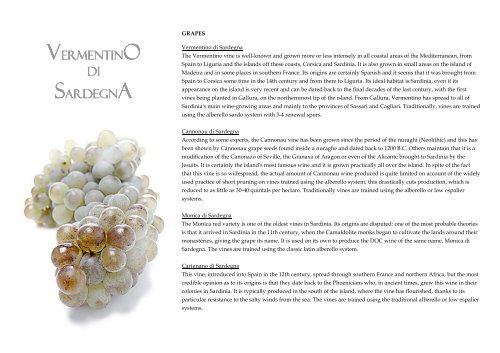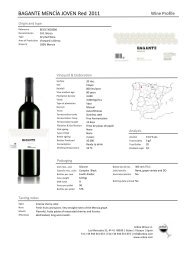Pala's roots go deep into the land of Sardinia. In these ... - Lahvino
Pala's roots go deep into the land of Sardinia. In these ... - Lahvino
Pala's roots go deep into the land of Sardinia. In these ... - Lahvino
You also want an ePaper? Increase the reach of your titles
YUMPU automatically turns print PDFs into web optimized ePapers that Google loves.
Vermentin<br />
ermentin<br />
ermentino<br />
ermentin<br />
di di<br />
di<br />
Sardegn ardegn ardegna<br />
ardegn<br />
GRAPES<br />
Vermentino di Sardegna<br />
The Vermentino vine is well-known and grown more or less intensely in all coastal areas <strong>of</strong> <strong>the</strong> Mediterranean, from<br />
Spain to Liguria and <strong>the</strong> is<strong>land</strong>s <strong>of</strong>f <strong>the</strong>se coasts, Corsica and <strong>Sardinia</strong>. It is also grown in small areas on <strong>the</strong> is<strong>land</strong> <strong>of</strong><br />
Madeira and in some places in sou<strong>the</strong>rn France. Its origins are certainly Spanish and it seems that it was brought from<br />
Spain to Corsica some time in <strong>the</strong> 14th century and from <strong>the</strong>re to Liguria. Its ideal habitat is <strong>Sardinia</strong>, even if its<br />
appearance on <strong>the</strong> is<strong>land</strong> is very recent and can be dated back to <strong>the</strong> final decades <strong>of</strong> <strong>the</strong> last century, with <strong>the</strong> first<br />
vines being planted in Gallura, on <strong>the</strong> nor<strong>the</strong>rnmost tip <strong>of</strong> <strong>the</strong> is<strong>land</strong>. From Gallura, Vermentino has spread to all <strong>of</strong><br />
<strong>Sardinia</strong>'s main wine-growing areas and mainly to <strong>the</strong> provinces <strong>of</strong> Sassari and Cagliari. Traditionally, vines are trained<br />
using <strong>the</strong> alberello sardo system with 3-4 renewal spurs.<br />
Cannonau di Sardegna<br />
According to some experts, <strong>the</strong> Cannonau vine has been grown since <strong>the</strong> period <strong>of</strong> <strong>the</strong> nuraghi (Neolithic) and this has<br />
been shown by Cannonau grape seeds found inside a nuraghe and dated back to 1200 B.C. O<strong>the</strong>rs maintain that it is a<br />
modification <strong>of</strong> <strong>the</strong> Canonazo <strong>of</strong> Seville, <strong>the</strong> Granaxa <strong>of</strong> Ara<strong>go</strong>n or even <strong>of</strong> <strong>the</strong> Alicante brought to <strong>Sardinia</strong> by <strong>the</strong><br />
Jesuits. It is certainly <strong>the</strong> is<strong>land</strong>'s most famous wine and it is grown practically all over <strong>the</strong> is<strong>land</strong>. <strong>In</strong> spite <strong>of</strong> <strong>the</strong> fact<br />
that this vine is so widespread, <strong>the</strong> actual amount <strong>of</strong> Cannonau wine produced is quite limited on account <strong>of</strong> <strong>the</strong> widely<br />
used practice <strong>of</strong> short pruning on vines trained using <strong>the</strong> alberello system; this drastically cuts production, which is<br />
reduced to as little as 30-40 quintals per hectare. Traditionally vines are trained using <strong>the</strong> alberello or low espalier<br />
systems.<br />
Monica di Sardegna<br />
The Monica red variety is one <strong>of</strong> <strong>the</strong> oldest vines in <strong>Sardinia</strong>. Its origins are disputed: one <strong>of</strong> <strong>the</strong> most probable <strong>the</strong>ories<br />
is that it arrived in <strong>Sardinia</strong> in <strong>the</strong> 11th century, when <strong>the</strong> Camaldolite monks began to cultivate <strong>the</strong> <strong>land</strong>s around <strong>the</strong>ir<br />
monasteries, giving <strong>the</strong> grape its name. It is used on its own to produce <strong>the</strong> DOC wine <strong>of</strong> <strong>the</strong> same name, Monica di<br />
Sardegna. The vines are trained using <strong>the</strong> classic latin alberello system.<br />
Carignano di Sardegna<br />
This vine, introduced <strong>into</strong> Spain in <strong>the</strong> 12th century, spread through sou<strong>the</strong>rn France and nor<strong>the</strong>rn Africa, but <strong>the</strong> most<br />
credible opinion as to its origins is that <strong>the</strong>y date back to <strong>the</strong> Phoenicians who, in ancient times, grew this wine in <strong>the</strong>ir<br />
colonies in <strong>Sardinia</strong>. It is typically produced in <strong>the</strong> south <strong>of</strong> <strong>the</strong> is<strong>land</strong>, where <strong>the</strong> vine has flourished, thanks to its<br />
particular resistance to <strong>the</strong> salty winds from <strong>the</strong> sea. The vines are trained using <strong>the</strong> traditional alberello or low espalier<br />
systems.



